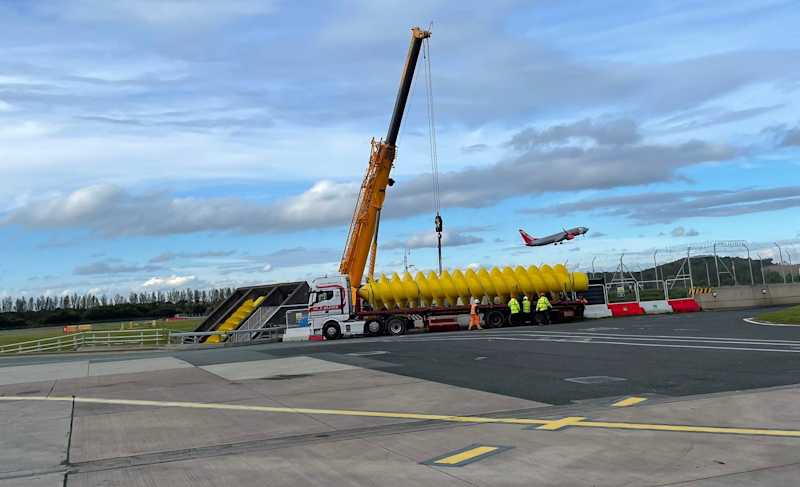A piece of history! Why our Archimedes' screw project was 50 years in the making

Refurbishing our Archimedes' screws
A project that's 50 years in the making has taken place on our airfield, and passengers with a keen eye for detail were able to watch it all from their plane seat.
History was made at the airport this year as our Archimedes' Screws were removed and refurbished for the first time since the 1970s.
These are some of our airfield's most distinctive, and most important, assets and tens of millions of passengers will have seen them in action down the years. Many no doubt wondering what exactly they do.
So let us help you out with that one.
These giant screws, each weighing 10 tonnes, collect all excess water from the airfield and surrounding area before filtering it and pumping it back out towards the River Almond.

You may be aware that Edinburgh Airport is one of the only in the UK to have a watercourse running through - the Gogar Burn - meaning it's extremely important we have measures in place to deal with a build up of water during heavy rainfall.
These screws were first introduced when the terminal was constructed in 1967 and for decades they did a fantastic job at keeping our airfield in good shape, but they were eventually going to need a refurbishment.
In early 2024 all three were removed and taken down to Nottingham to be worked on, with a short-term contingency put in place on our airfield while they're away.
This also presented an opportunity for our teams to paint part of the concourses the screws sit in to prevent the build up of algae, and replace some of the bearings and gearboxes - ensuring a nice new environment once the screws return.
Why are they called Archimedes' screws?
Used to 'raise water', the device is said to have been invented by ancient Greek scientist Archimedes, who first described it in 234 BC. So the technology has been around a while...
It is believed that they were first designed to remove water leaking through the hull of a luxury ship. At this point the screw was turned by hand.
Fair to say our teams are relieved technology has moved on since then.
These days they are used in a number of different settings, including at the Leaning Tower of Pisa. An Archimedes' screw was used to stabilise the structure when it was leaning too much. Subsoil saturated by groundwater on one side of the tower was removed and the weight of the structure then corrected the over-compensated lean.
After months away being refurbished, tested, and given a nice new coat of fluorescent yellow paint, the screws were back on site in September, ready for reinstallation.
When we say 'back on site' we are of course referring to a live airfield, with aircraft arriving and departing every few minutes.
This presents a challenge in itself, and meant a great deal of careful planning for the airport's compliance team. They worked to ensure certain stands used to park aircraft were kept free to allow the delivery and reinstallation of these important assets.

After arriving on the back of trucks each screw was lifted using a crane - which was only allowed to be a certain height due to airfield regulations - before being carefully placed into the concourse and reconnected.
An insight from the project manager
Duncan Logan from the airport's project management team, led the Archimedes Screw refurbishment project, and he said:
"They've been fully refurbished and all the electricals have been replaced with new equipment. The concrete structure itself has also had repairs made, and this will all lead to cleaner water being recycled back into the burn.
"This is the first refurbishment the screws have ever had, they've been here for around 50 years since the terminal was first built. There were a lot of unknowns as a result, but this work should safeguard it for the next 30 or 40 years.
"The project has taken around a year to develop. Because the site is slap bang in the middle of the airfield, and we've got the airspace above us, there is a height restriction on the crane. We've also got two taxiways nearby, and we've got aircraft coming into the nearby stands. These things all make it a wee bit more complicated for us."
And why are they yellow?
"We asked a number of questions - including of airside operations - around why they were originally yellow, but we've never really found out exactly why. So to stick with the original design we decided to continue with the fluorescent yellow."
Quick links
Check-in desk times
Different airlines operate different rules.
When you should arrive
It's the age-old question, and there are several things to consider.
Your pre-travel checklist
Key things to remember before you arrive at the airport.
Prepare for security
A quick guide to navigating airport security like a pro.





